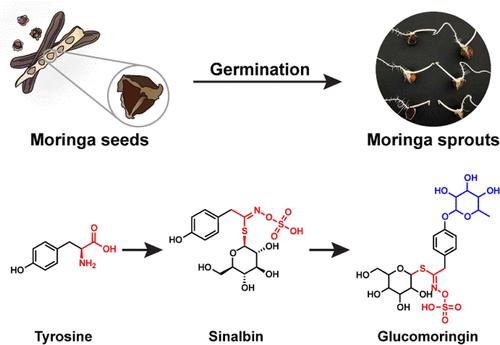当前位置:
X-MOL 学术
›
J. Agric. Food Chem.
›
论文详情
Our official English website, www.x-mol.net, welcomes your
feedback! (Note: you will need to create a separate account there.)
Germination Increases the Glucomoringin Content in Moringa Sprouts via Transforming Tyrosine
Journal of Agricultural and Food Chemistry ( IF 5.7 ) Pub Date : 2024-05-06 , DOI: 10.1021/acs.jafc.4c01517 Yi Liu 1 , Haijuan Zhang 1 , Zhuoyang Zhao 1 , Xingwei Wang 1, 2 , Yi Kai 1 , Dejian Huang 1, 3 , Shao-Quan Liu 1, 3 , Yuyun Lu 1
Journal of Agricultural and Food Chemistry ( IF 5.7 ) Pub Date : 2024-05-06 , DOI: 10.1021/acs.jafc.4c01517 Yi Liu 1 , Haijuan Zhang 1 , Zhuoyang Zhao 1 , Xingwei Wang 1, 2 , Yi Kai 1 , Dejian Huang 1, 3 , Shao-Quan Liu 1, 3 , Yuyun Lu 1
Affiliation

|
Moringa seeds are an excellent dietary source of phytochemicals (i.e., glucosinolates, GSLs; isothiocyanates, ITCs) with health-beneficial effects. Although numerous studies have been conducted on moringa seeds, the effect of germination on the regulation of GSLs remains scarcely explored. The present study investigated the dynamic changes of GSLs in moringa seeds during germination (at 25, 30, and 35 °C for 6 days in the dark) through an untargeted metabolomics approach and compared the antioxidant capacity of ungerminated and germinated moringa seeds. Our results showed that germination significantly increased the total GSL content from 150 (day 0) to 323 μmol/g (35 °C, day 6) on a dry weight (DW) basis, especially glucomoringin (GMG), the unique glucosinolate in moringa seeds, which was significantly upregulated from 61 (day 0) to 149 μmol/g DW (35 °C, day 4). The upregulation of GMG corresponded to the metabolism of tyrosine, which might be the initial precursor for the formation of GMG. In addition, germination enhanced the total ITC content from 85 (day 0) to 239 μmol SE/g DW (35 °C, day 6), indicating that germination may have also increased the activity of myrosinase. Furthermore, germination remarkably increased the total phenolic content (109–507 mg GAE/100 g DW) and antioxidant capacity of moringa seeds. Our findings suggest that moringa sprouts could be promoted as a novel food and/or ingredient rich in GMG.
中文翻译:

发芽通过转化酪氨酸增加辣木芽中的葡萄糖苷含量
辣木种子是植物化学物质(即芥子油苷、GSL;异硫氰酸盐、ITC)的极好膳食来源,具有有益健康的作用。尽管对辣木种子进行了大量研究,但发芽对 GSL 调节的影响仍然很少被探索。本研究通过非靶向代谢组学方法研究了辣木种子在发芽过程中(25、30和35°C,黑暗中6天)中GSL的动态变化,并比较了未发芽和发芽辣木种子的抗氧化能力。我们的结果表明,以干重 (DW) 计,发芽后的总 GSL 含量显着增加,从 150(第 0 天)增加到 323 μmol/g(35 °C,第 6 天),尤其是辣木中独特的芥子油苷 (GMG)种子的 DW 值从 61(第 0 天)显着上调至 149 μmol/g DW(35 °C,第 4 天)。 GMG的上调与酪氨酸的代谢相对应,酪氨酸的代谢可能是GMG形成的最初前体。此外,发芽将总 ITC 含量从 85(第 0 天)提高到 239 μmol SE/g DW(35 °C,第 6 天),表明发芽可能还增加了黑芥子酶的活性。此外,发芽显着增加了辣木种子的总酚含量(109-507 mg GAE/100 g DW)和抗氧化能力。我们的研究结果表明,辣木芽可以作为富含 GMG 的新型食品和/或成分进行推广。
更新日期:2024-05-06
中文翻译:

发芽通过转化酪氨酸增加辣木芽中的葡萄糖苷含量
辣木种子是植物化学物质(即芥子油苷、GSL;异硫氰酸盐、ITC)的极好膳食来源,具有有益健康的作用。尽管对辣木种子进行了大量研究,但发芽对 GSL 调节的影响仍然很少被探索。本研究通过非靶向代谢组学方法研究了辣木种子在发芽过程中(25、30和35°C,黑暗中6天)中GSL的动态变化,并比较了未发芽和发芽辣木种子的抗氧化能力。我们的结果表明,以干重 (DW) 计,发芽后的总 GSL 含量显着增加,从 150(第 0 天)增加到 323 μmol/g(35 °C,第 6 天),尤其是辣木中独特的芥子油苷 (GMG)种子的 DW 值从 61(第 0 天)显着上调至 149 μmol/g DW(35 °C,第 4 天)。 GMG的上调与酪氨酸的代谢相对应,酪氨酸的代谢可能是GMG形成的最初前体。此外,发芽将总 ITC 含量从 85(第 0 天)提高到 239 μmol SE/g DW(35 °C,第 6 天),表明发芽可能还增加了黑芥子酶的活性。此外,发芽显着增加了辣木种子的总酚含量(109-507 mg GAE/100 g DW)和抗氧化能力。我们的研究结果表明,辣木芽可以作为富含 GMG 的新型食品和/或成分进行推广。































 京公网安备 11010802027423号
京公网安备 11010802027423号